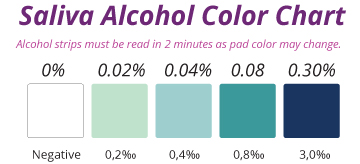ALCO-SCREEN® 2 Minute Saliva Test for Blood Alcohol
Intended Use
ALCO-SCREEN®, by Chematics, is a saliva alcohol test intended for use as a rapid, highly sensitive non-invasive method for the objective determination of alcohol ingestion. With positive results, relative blood alcohol concentration may be approximated by colorimetric visual observation. For applications requiring a quantitative determination of blood alcohol concentration, a positive ALCO-SCREEN® result must be verified using an acceptable quantitative alcohol procedure. ALCO- SCREEN® requires no special training provided that instructions are followed carefully. In the event of a positive result, quantitative evidentiary testing should be performed by a qualified professional.
ALCO-SCREEN® may also be used to qualitatively detect the presence of alcohol in many other fluids, such as drinks, blood serum etc. See Limitations for further information.
Summary
Excess or inappropriate consumption of alcohol is a common and pervasive social problem. It is a contributory factor to many accidents, injuries and medical conditions. Screening of individuals for alcohol consumption is an important method for the identification of individuals who might be at risk due to alcohol use or intoxication. Screening is also an important deterrent against inappropriate alcohol consumption.
The blood alcohol concentration at which a person becomes impaired is variable dependent on the individual. Parameters specific to the individual such as physical size, weight, activity level, eating habits and alcohol tolerance all affect the level of impairment.
Precautions
ALCO-SCREEN® is a visually interpreted test where observation of color development is used to detect the presence of alcohol and color matching may be used to provide an approximation of blood alcohol concentration. As such, exact interpretation of results is not required in most cases. However, persons who are color blind or visually impaired may experience difficulty when a more specific interpretation is required.
Do not open test package until immediately before performing the test procedure.
Test materials that have been exposed to saliva should be treated as potentially infective. These materials should be returned to the original foil package and disposed of in a sanitary manner.
Never use ALCO-SCREEN® after the expiration date marked on the outside of each test package, or if the test package appears damaged or otherwise compromised.
Procedure
- Abstain from placing anything in the mouth for fifteen (15) minutes prior to beginning the test. This includes non-alcoholic drinks, tobacco products, coffee, breath mints, food, etc.
- Open the foil package and remove the test strip. Observe the reactive pad on the end of the test strip. The pad should be a light cream color. A test strip with a reagent pad which is dark tan in color or otherwise discolored must be discarded.
- Saturate the reactive pad with saliva from mouth or sputum cup. Immediately start timer.
- At two (2) minutes observe the color change (if any) in the reactive pad. A color change of green or blue indicates the presence of alcohol and a positive result. Results obtained after more than 2 minutes and 30 seconds may be erroneous.
Estimate the approximate blood alcohol concentration by comparing the color of the reagent pad with the color chart appearing on the test package.
Results
ALCO-SCREEN® produces a color change in the presence of saliva alcohol ranging from a light green-gray color at 0.02% (
0,20‰) blood alcohol concentration to a dark blue-gray color near 0.30% (3,0‰) blood alcohol concentration. Color blocks are provided within this range to allow an approximation of blood alcohol concentration to be made. ALCO-SCREEN® may produce colors that appear to be between adjacent color blocks.
ALCO-SCREEN® is very sensitive to the presence of alcohol. A green color that is lighter than the 0.02% color block should be interpreted as being positive to the presence of alcohol in saliva but less than 0.02% (
0,20‰) blood alcohol.
A result where the reagent pad shows no color change (remains white or cream colored) should be interpreted as a negative result (no alcohol present).
A result where the outer edges of the reagent pad produces a slight color but the majority of the pad remains colorless should be repeated to ensure complete saturation of the reagent pad with saliva. If the second result is the same, the results should be interpreted as being negative (no alcohol present).


Controls
The color reaction with alcohol in saliva is somewhat slower and less intense than with alcohol in aqueous solutions.
Negative: No color change on reactive pad
Positive: Reactive pad changes color in 2 minutes
Performance Characteristics
ALCO-SCREEN® is highly effective as an objective determinant for alcohol ingestion. ALCO-SCREEN® demonstrated an accuracy of greater than 95% in correctly identifying the presence or absence of measurable alcohol in blood.